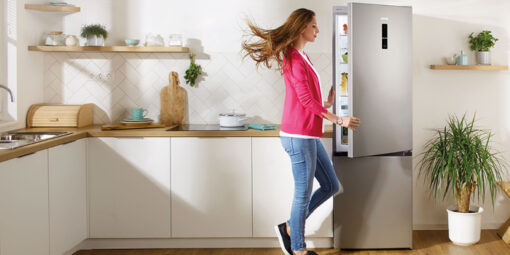Water Or Ice In The Refrigerator: Here’s What It Means

Water or ice build-up in the fridge is never a good sign. Here’s how you can fix or avoid it.
Have you ever wondered why ice accumulates in the refrigerator or why there is a water leak coming out of it? These certainly are not a part of normal operation and will need some attention from you or even a service technician. Let’s check what you can do about it first.
Make sure refrigerator the door is completely closed
If the door is not closed properly, the refrigerator heats up and condensation starts to form. Hence water starts to accumulate and you can get drips that turn into a leak. Therefore, do make sure the door is closed properly and is not obstructed by anything. The first thing to check is if the door fits well. If it’s loose, it’s probably a rubber door seal malfunction. Keep in mind that, as per most manufacturers’ instruction manuals, rubber door seals should be cleaned regularly, at least once every six months.
Okay, you forgot, it happens. How can you easily inspect if the seal is still doing its job? Unplug the appliance for about two minutes and open the door. Insert the plug back into the electric socket and close the fridge door. Then swipe your fingers along the rubber seals. If you feel the air pulling inwards, this means that the rubber door seals are no longer sealing well and will need to be replaced. Preferably by a service technician.
Check if you left the holiday mode on
If you have enabled the holiday mode function in your longer absence, this will keep the fridge running at higher temperatures which can lead to condensation and water drops forming. Check if the vacation or any energy-saving functions are turned on and disable them.

Separate food to improve ventilation
The refrigerator has to breathe too. This means creating enough space inside to allow for decent airflow. Arrange the foods in the refrigerator so that there is enough space between them. No food should touch the back wall of the refrigerator, as this negatively affects the airflow downwards and may lead to ice accumulation at the bottom. Also, check and make sure that the vents of the refrigerator and freezer are not blocked.
There’s a hole in my fridge!
Yes, there is. And with a good reason. It’s called the defrost drain. Food particles or other foreign objects are easily trapped in the drain. If debris accumulates, the drain can become clogged and water begins to leak. If you think the drain is clogged, turn off the power and wait for it to thaw.
It’s also a good idea to periodically clean the defrost drain on any debris. While hot water drain cleaning might work best for clogged drains in the bathroom, it’s a big mistake to apply it to the fridge. Never pour hot water directly into the defrost drain or inside the refrigerator as this can cause internal problems with the refrigerator. Use a thin stick instead, many refrigerators have it included – check the items you received with your purchase.
Don’t put any hot stuff in the refrigerator
This seems logical enough. Every user manual clearly states not to store hot or cooked food directly in the refrigerator, as it may increase the humidity in the freezer and cause ice to form. Therefore, simply wait for the food to cool before placing it in the refrigerator.
Is your fridge on a flat surface?
Last but not least, one of the reasons for trouble can also be uneven ground on which the refrigerator is placed. In this case, its door may not fit tightly. You probably know the rest of the story: warm air seeps into the compartment, the refrigerator tries to compensate for excessive heat and works too hard, freezing food. In this case, as in the case of a leaky sealant and the drainage hole cannot cope with an abnormal amount of water, internal and external “floods” occur.






